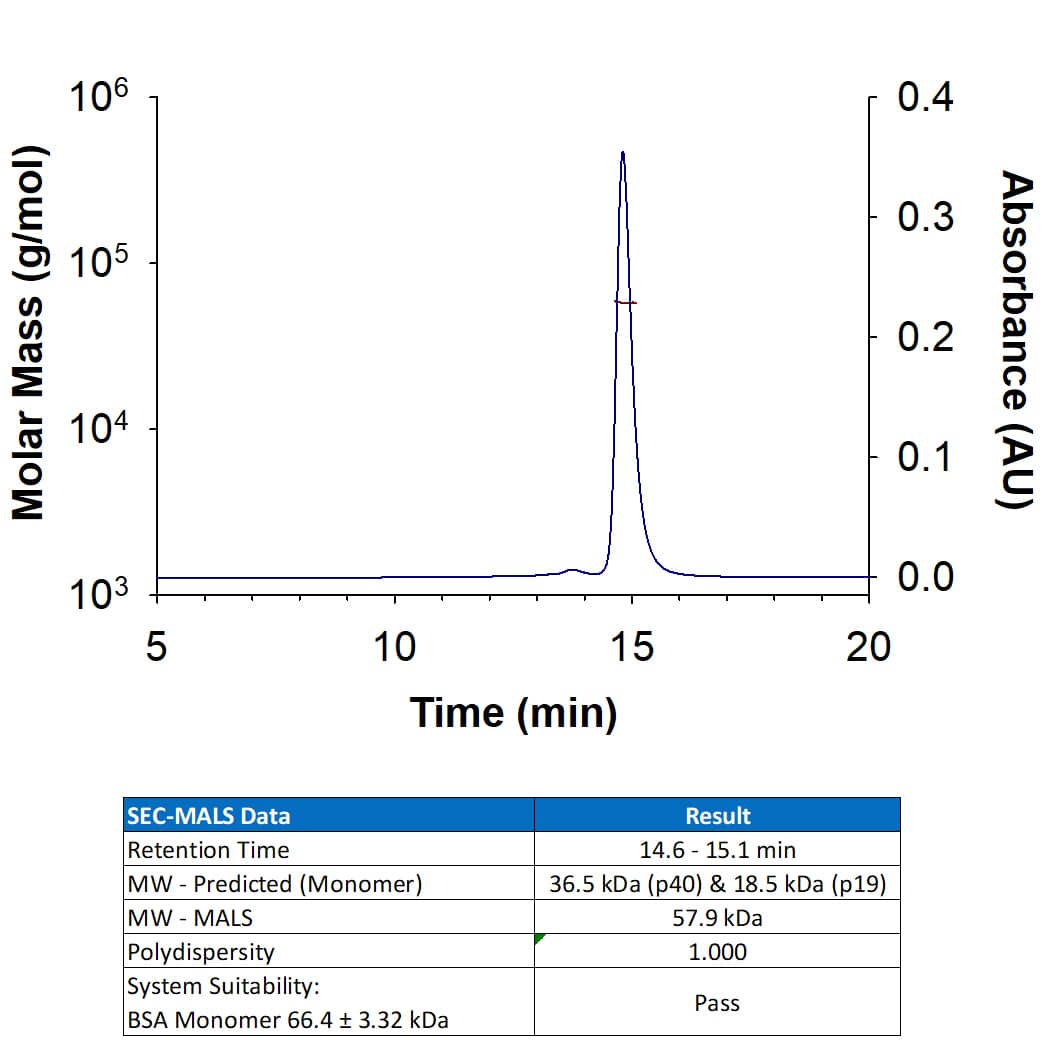Recombinant Human Semaphorin 7A Fc Chimera Protein, CF
Recombinant Human Semaphorin 7A Fc Chimera Protein, CF Summary
Product Specifications
| Human Semaphorin 7A (His47-Ala648) Accession # O75326 |
IEGRMD | Human IgG1 (Pro100-Lys330) |
| N-terminus | C-terminus | |
Analysis
Customers also Viewed
Product Datasheets
Carrier Free
CF stands for Carrier Free (CF). We typically add Bovine Serum Albumin (BSA) as a carrier protein to our recombinant proteins. Adding a carrier protein enhances protein stability, increases shelf-life, and allows the recombinant protein to be stored at a more dilute concentration. The carrier free version does not contain BSA.
In general, we advise purchasing the recombinant protein with BSA for use in cell or tissue culture, or as an ELISA standard. In contrast, the carrier free protein is recommended for applications, in which the presence of BSA could interfere.
2068-S7
| Formulation | Lyophilized from a 0.2 μm filtered solution in PBS. |
| Reconstitution | Reconstitute at 200 μg/mL in PBS. |
| Shipping | The product is shipped at ambient temperature. Upon receipt, store it immediately at the temperature recommended below. |
| Stability & Storage: | Use a manual defrost freezer and avoid repeated freeze-thaw cycles.
|
Background: Semaphorin 7A
Semaphorin 7A (Sema7A, designated CD108, previously Sema K1 or Sema L), is an ~80 kDa membrane-anchored glycoprotein that is a member of the Semaphorin family of axon guidance molecules (1 ‑ 4). On human erythrocytes, it is the John Milton Hagen (JMH) blood group antigen (4). Sema7A is the only known Class 7 or glycophosphatidylinositol (GPI)-linked semaphorin; its expression is concentrated in the brain, spleen and thymus (1 ‑ 5). Human Sema7A cDNA encodes a 44 amino acid (aa) signal sequence, a 604 aa extracellular domain (ECD) including Sema and C2‑type Ig-like domains, and an 18 aa propeptide/GPI membrane anchor signal sequence. Mature human Sema7A shares 89%, 89%, 88%, 86% and 90% aa identity with mouse, rat, canine, bovine and equine Sema7A, respectively. The Sema7A sema domain contains an RGD integrin interaction motif (4). Although it binds plexin-C1 in vitro and may be coexpressed with it, many of its activities depend on interaction with beta 1 integrins such as alpha 1 beta 1 (6 ‑ 10). Sema7A signaling through the two receptors may cause opposing effects (8). Sema7A is an immune semaphorin, with expression and activity on CD4+CD8+ thymocytes, activated T cells, macrophages and microglia (2, 9 ‑ 12). T cell Sema7A interacts with monocytic cells, stimulating their chemotaxis, production of pro-inflammatory cytokines, and dendritic differentiation (5, 6). However, on the T cells themselves, Sema7A downregulates TCR signaling by promoting TCR internalization, modulating T cell responses (9). In lung macrophages, Sema7A is induced by TGF-beta and participates in TGF-beta -induced lung fibrosis (12). Sema7A is also expressed on pre-osteoblasts and osteoclasts, where it promotes migration and fusion, respectively; on keratinocytes, where it promotes melanocyte spreading and dendricity; and on some neurons, for example, promoting axon outgrowth in the developing olfactory tract (8, 10, 13).
- Yazdani, U. and J.R. Terman (2006) Genome Biol. 7:211.
- Kikutani, H. et al. (2007) Adv. Immunol. 93:121.
- Sato, Y. and Takahashi H. (1998) Biochim. Biophys. Acta. 1443:419.
- Yamada, A. et al. (1999) J. Immunol. 162:4094.
- Holmes, S. et al. (2002) Scand. J. Immunol. 56:270.
- Suzuki, K. et al. (2007) Nature 446:680.
- Pasterkamp, R.J. et al. (2007) BMC Dev. Biol. 7:98.
- Scott, G.A. et al. (2007) J. Invest. Dermatol. 128:151.
- Czopik, A.K. et al. (2006) Immunity 24:591.
- Pasterkamp, R.J. et al. (2003) Nature 424:398.
- Mine, T. et al. (2000) Tissue Antigens 55:429.
- Kang, H.-R. et al. (2007) J. Exp. Med. 204:1083.
- Delorme, G. et al. (2005) Biol. Cell 97:589.
Citations for Recombinant Human Semaphorin 7A Fc Chimera Protein, CF
R&D Systems personnel manually curate a database that contains references using R&D Systems products. The data collected includes not only links to publications in PubMed, but also provides information about sample types, species, and experimental conditions.
4
Citations: Showing 1 - 4
Filter your results:
Filter by:
-
Semaphorin 7A promotes endothelial permeability and inflammation via plexin C1 and integrin ?1 in Kawasaki disease
Authors: Huang, J;Zhao, C;Zhang, S;
BMC pediatrics
Species: Human
Sample Types: Whole Cells
Applications: Bioassay -
Semaphorin-7A on Exosomes: A Promigratory Signal in the Glioma Microenvironment
Authors: I Manini, ME Ruaro, R Sgarra, A Bartolini, F Caponnetto, T Ius, M Skrap, C Di Loreto, AP Beltrami, G Manfiolett, D Cesselli
Cancers (Basel), 2019-05-30;11(6):.
Species: Human
Sample Types: Whole Cells
Applications: Bioassay -
Beta 1-integrin ligation and TLR ligation enhance GM-CSF-induced ALDH1A2 expression in dendritic cells, but differentially regulate their anti-inflammatory properties
Sci Rep, 2016-11-29;6(0):37914.
Species: Mouse
Sample Types: Whole Cells
Applications: Bioassay -
Semaphorin 7A Aggravates Pulmonary Inflammation during Lung Injury.
Authors: Roth J, Kohler D, Schneider M, Granja T, Rosenberger P
PLoS ONE, 2016-01-11;11(1):e0146930.
Species: Human
Sample Types: Whole Cells
Applications: Bioassay
FAQs
No product specific FAQs exist for this product, however you may
View all Proteins and Enzyme FAQsReviews for Recombinant Human Semaphorin 7A Fc Chimera Protein, CF
Average Rating: 4 (Based on 1 Review)
Have you used Recombinant Human Semaphorin 7A Fc Chimera Protein, CF?
Submit a review and receive an Amazon gift card.
$25/€18/£15/$25CAN/¥75 Yuan/¥2500 Yen for a review with an image
$10/€7/£6/$10 CAD/¥70 Yuan/¥1110 Yen for a review without an image
Filter by:














